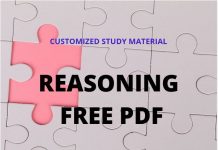Statement & Courses of Action Tips and Tricks for IBPS, SBI, SSC, RRB, RBI, Railway, LIC,IAS,SSB Exams.
We are providing you Important Concept & Short Tricks on Statement & Courses of action Questions in Reasoning which are usually asked in Bank Exams. Use these below given short cuts to solve questions within minimum time. These shortcuts & Concept will be very helpful for your upcoming All Bank Exam 2016.
To make the chapter easy for you all, we are providing you all some Important Concept & Short Tricks on Statement & Courses of action? which will surely make the chapter easy for you all.
Such questions are asked to test your ability to judge a problem correctly, to determine the root cause of the problem and then to prescribe a suitable course of action.
What is Courses of Action?
A courses of Action is a step or administrative decision to be taken up for improvement or follow – up for further action in regard to the problem, policy etc. on the basis of the information given in statement.
Normally there will be two broad types of pattern in such questions:
1. Problem and Solution based: When the presented situation talks of a problem and the suggested course of action talk of a solution.
- It solves / reduces of minimize the problem
- the solution or course of action is practically Possible.
- A suggested course of actions can be said to solve/reduce/minimize, the problem.
When; (a) It is an established fact. ie, It is acknowledged universally as a fact.
Note: A suggested course of action may indeed solve a problem but in practical life it may not be advisable or possible. If it is so, then the course of action is rejected.
For e.g. –
Statement: A large number of people in ward X of the city are diagnosed to be suffering from a fatal malaria type.
Courses of Action: I. The city municipal authority should take immediate steps to carry out extensive fumigation in ward X.
1. The people in the area should be advised to take steps to avoid mosquito bites.
(1). Only I follows
(2). Only II follows
(3). Either I or II follows
(4). Neither I nor II follows
(5). Both I and II follow
Answer is (5) – Clearly, prevention from mosquitoes and elimination of mosquitoes are two ways to prevent malaria. The action will reduce the problem. So, both the courses follow.
2. Fact and Improvement based: When the presented situations talks of a simple fact (not a problem, just a situation) and the suggested courses of action suggest ways of improvement.
Format of the Problem: These types of questions contain two or more statement and these statements are followed by the number of Courses of Action. You have to find which Course of Action will logically follow from the given statement.
For e.g.-
Statement: Exporters in the capital are alleging that commercial banks are violating a Reserve Bank of India directive to operate a post shipment export credit denominated in foreign currency at international rates from January this year.
Courses of Action: I. The officers concerned in the commercial banks are to be suspended.
II. The RBI should be asked to stop giving such directives to commercial banks.
(1) Only I follows
(2) Only II follows
(3) Either I or II follows
(4) Neither I nor II follows
(5) Both I and II follow
Answers (4) – The statement mentions that the commercial banks violate a directive issued by the RBI. The remedy is only to make the banks implement the Act. So, none of the courses follows.
Steps to Solve
What is the approach to solve the questions of this section?
1. Don’t make your individual perception.
2. Act according to the rules of any organization.
3. Go for impartial and personal thinking.
4. Existing practices are not effective Course of Action.
5. Whenever problem arises, it is always sensible course of action to find out the cause.
Important Points to proceed step by step to reach final courses of action:
1. Extreme or strict action is not valid course of action.
2. The actions should be a positive step towards the solution of the problem, rather harsh and undemocratic.
3. Analyses course of action whether it will solve the problem or lessen it. For proper analysis check with
(i) Universal truth
(ii) Experience
(iii) Logic
4. Check out practical course of action. Simple problem must have simple course of action, not a complex one which might create more problem than to solve or reduce.
5. In most of the cases, a situation has more than one course of action. But they are never exclusive to each other. So our answer should be always “both follow” and not “either of them follows”.
6. If course of action and problems are properly balanced and if the course of action is also feasible than that action can be followed.
Sample Questions
1. Statement : Youngsters are often found staring at obscene posters.
Courses of Action :
I) Children should be punished and penalized if they are found doing so.
II) Any display of such materials should be banned.
(1) Only I follows
(2) Only II follows
(3) Either I or II follows
(4) Neither I nor II follows
(5) Both I and II follow
Ans (2) only II follows.
Explanation: Bad things attract more and punishment after the act has been committed is no remedy. The act should be prevented so only II follows.
2. Statement: Footpaths of a busy road are crowded with vendors selling cheap items.
Courses of Action :
I) The help of police should be sought to drive them away.
II) Some space should be provided to them where they can earn their bread without blocking footpaths.
(1) Only I follows
(2) Only II follows
(3) Either I or II follows
(4) Neither I nor II follows
(5) Both I and II follow
Ans (5) Both I and II follow
Explanation: The best solution for the problem is to give an alternative to it. II suggests an alternative and hence follows. But how can we be sure that the vendors would leave the footpaths if they are given alternative means of livelihood? For that we have to use force and hence I also follows.
3. Statement: Rapid growth of urban population has led to a severe shortage of living space resulting in a drop in living conditions .
Courses of Action:
I) The Government should draw plans for urban re planning and development.
II) All village to town migrations should be stopped .
II) The Government should demolish the five-star hotels and build peoples cottages there.
(1) Only I follows
(2) Only III follows
(3) I & III follow
(4) I & II follow
(5) All follow
Ans (1) Only I follows.
Explanation: I is a positive step towards the solution of the problem. III is rather harsh and undemocratic. II too is an extreme action. Both II & III would violate the Fundamental Rights of the Indian Constitution.
4. Statement : Although advancement medical science has raised life expectancy, the rate of child mortality remains high in India.
Courses of Action :
I) Efforts should be made to lower life expectancy.
II) Medical scientists should be asked to give up their jobs.
III) Efforts should be made to decrease the rate of child mortality.
(1) I & II follow
(2) II & III follow
(3) I & III follow
(4) Only I follows
(5) Only III follows
Ans (5) Only III follows.
Explanation: I is an absurd suggestion. II is an extreme action not required in the present circumstances. III is undeniably a proper course of action.
2) e Both I and II are established facts and hence both I and II follows.
3) b It is an established fact that a teenager who takes drugs will never stop it if he is beaten by the police. But the right action is to take him to a rehabilitation centre. Hence only II follows.
4) d Both I and II are vague. It lacks substance. Nothing concrete is being said here.
5) a If floods occur this year too, I is likely to yield positive results. II is a negative approach. We must refrain from panic but a healthy fear is desirable.
6) e When the Government takes such an action it is necessary that people are made aware of the consequences they would face if they do not obey the directive . Hence II follows. I is obvious.
7) d Against an epidemic, precautionary measures should be taken every year and not every four years. Hence I does not follow. II is not a preventive action against conjunctivitis. Hence II also does not follow.
8) a To improve the hygienic conditions is always a welcome step and in view of the statement it becomes even more necessary. Hence, I unquestionably follows. But II does not. We should not medicate any child unless he has actually contracted the disease. Prevention is all right but curing should begin only after the disease has been contracted.
9) b I is an absurd suggestion. When one industry is facing trouble because of regulations, it talks of regulating the supply of other industrial raw materials too. II is a better action because it would tend to solve the problem.
10) a The Statement mentions a problem that most of the development plans develop on paper only. They are not materialised in reality. This problem could be solved if field work was supervised properly. Hence I follows. But II is a absurd suggestion. The issue is lack of actual field work and not misuse of paper.














